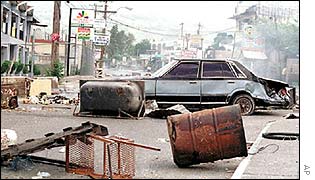Violence and Drugs in Jamaica
English | Francais

It is obvious that Jamaica has an exceeding amount of problems in the areas of drugs and violence. The statistics has actually caught up with the problems and the country dropped in about 20 places in the final standings of last year.1 There have been problems in terms of economy, drugs and criminal violence all over Jamaica.
Various parts of Latin America isn't faring so well, particularly Venezuela, Colombia, and especially Jamaica, which have lower per-capita incomes now than they did 10 years ago.2 Jamaica has a population of about 2.6 million. 3 Within one year, there existed 953 murders. 4 Most of these murders were located in Jamaica’s capital Kingston. Also, within that year, 145 expected criminals were shot dead by the police. That’s 1098 deaths that year relating to murder!

Because the economy is crashing, the government is still struggling to maintain law and order, which makes it even harder to control the growth of the usage of drugs and violence in this country.4
Of the island’s 2.6 million residents, more that 1.5 million live in the metro area. Only about 80 000 live in the western belt. More than 79% of the crime in the metro area is down there, or linked to people from there. The gun battles were literally confined almost entirely to Kingston West.5
A study made by A. Harriott illustrates that the homicide rate in Jamaica is four times higher than the world’s rate, with the city of Kingston having the highest rate in the world at 109/100,000, followed by Washington D.C., at 67/100,000. According to her, there is a straight relationship between the rate of murder and the rates of other violent crimes-robberies, rapes, etc. In Jamaica, historically, most murders were crimes of passion. In 1963, in 64% of the murder cases, the victims were known to the offender, and domestic violence accounted for 28% of all homicides, while in 1993, this declined to 16%. This does not mean that cases of domestic violence are on the decline, it means that the murder rate - especially since the increase in the number of illegal guns on the island - is going up.

Coinciding with the information stated above, statistics from the Jamaica police Sexual Offense Unit indicate that, in 1997, 1,857 cases of sexual offenses were filed, of which 40% involved rape and bodily harm, along with 97 cases of incest, 56 assaults with intent to rape, and 29 cases of attempted rape. Between January 1 and November 15, 1998, 760 cases of rape and 455 of physical abuse were reported.
It was not until 1998 that Jamaican police began to break down homicide statistics by sex. That year, 92 women and 18 children were reported murdered. It is assumed that a significant proportion of these deaths took place within the context of domestic violence.6
Jamaica is simply a mess. Their streets suffer from violence and drugs, there have been several riots in the past year and sadly, this all is common for all of the children who live within those areas.
Along Luke Lane, a narrow, clustered side street located in one of Kingston West’s busiest markets, on barrels, footstools and tables are piles of thick, bushy buds of marijuana, trumpeted by vendors who puff away all day. Rastafarians consider the smoking of marijuana to be a sacrament and have long resisted the banishment of the herb. Even though marijuana has been legalized for only private, medical or religious reasons, people still break that law and smoke the herb publicly without hesitation.

1"Worldwide Quality of Life Review," http://www.escapeartist.com/international/01_qolife.html
2Ibid.
3Ibid.
4Ibid.
5A 1998 Toronto Star Article
6"UNDP Against Violence, Jamaica," http://www.undp.org/rblac/gender/jamaica.htm
 A Krista de la Rama, Joshua Liu, and Lauren Wood Production | 2002-2003
A Krista de la Rama, Joshua Liu, and Lauren Wood Production | 2002-2003
|